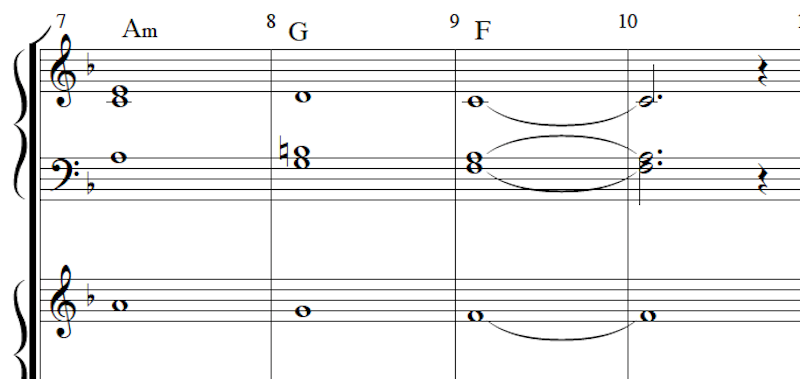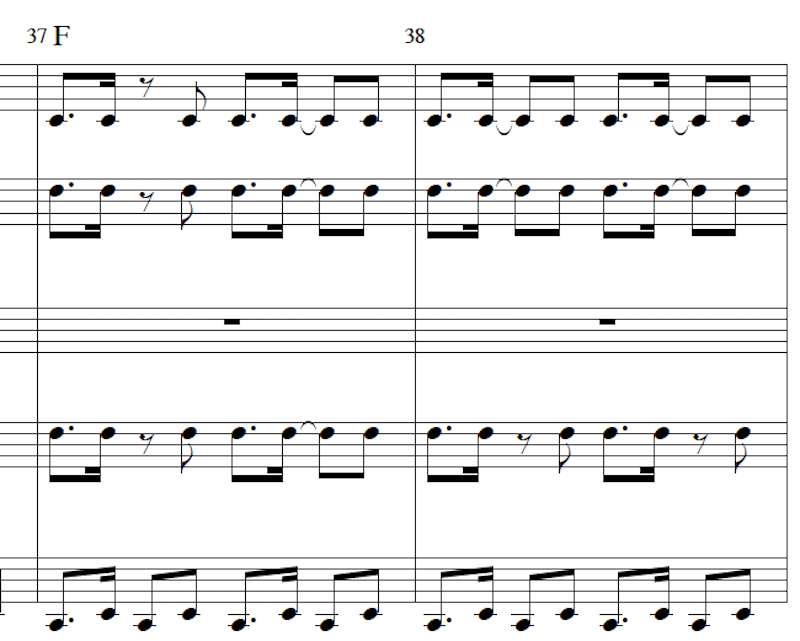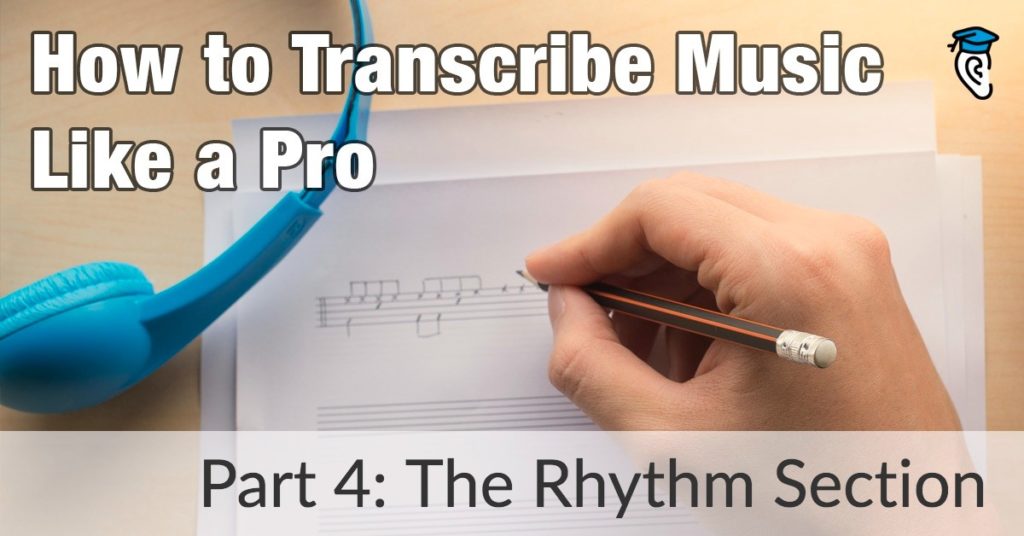Now that you have learned the basics of transcription, used the drums to work out the song’s structure, and figured out the key of the tune, it’s time to conquer some meat and potatoes: a full transcription of the rhythm section.
The rhythm section provides the basic musical structure and harmony of a tune. This will be the part of your song transcription that will take more time, mainly because it can involve several instruments and working out the chord progressions.
Some musicians—like bassists, guitarists, and pianists—may find this the easiest section to figure out because they play in the rhythm section. But if you are a lead singer, percussionist, or play a mostly melodic instrument like saxophone or flute, it may take a little work to figure out this section in full.
What is the Rhythm Section?
First things first: we’re not talking about a section of the song like we did when discussing looping a certain section. We’re talking about a section of the band.
The rhythm section usually includes the rhythm guitar, the piano, bass player, and the drums.
We’ve already covered transcribing the drum part earlier in the series, so now we are focusing on the piano/bass/guitar. Not every song will have these exact instruments. For example, in dance electronica, you might have a synth pad for the bass and the rhythm guitar part created with a sequencer playing bizarre sounds. In other songs, the piano might have the lead or there might not be a rhythm guitar part at all.
In our running example in this series, the rhythm section would be the analog pad and the chords played by electronic keyboard. The lighter “bell tone” plays notes of the melody. This example is a very basic arrangement to make transcription simple to understand. Most songs are much more complex!
Rhythm Section Examples
In the examples below, see if you can identify which instruments are playing the “lead” role and which are part of the rhythm section. The bass part typically plays simple rhythms and often holds out a single note that corresponds to the tonic of the chords. The other instruments, like guitar or piano, will play chord variations. You may hear other instruments in the mix. While these are all important, typically when you are transcribing you want to work out the most important parts of the tune and don’t necessarily need to figure out the entire detailed orchestration.
In Adele’s “Send My Love” you can hear a bass and a guitar playing in the rhythm section. Adele’s voice is the lead. She sings in harmony with herself. There is also a light synth part. Listen to how complex even a pop song can be in terms of instrumentation.
“Whip My Hair” has a very standard setup for hip-hop. You can hear a low pad holding out notes, you can hear chords in the synth, and there are sections that don’t even have harmony, leaving it to the percussion to do the work.
How to Transcribe the Rhythm Section
Let’s try transcribing the rhythm section for our running example. Try to figure out the chord progression of this simple instrumental track.
Typically it helps to have already figured out the different sections of a piece, like we did when transcribing the drums. Sometimes a section is repeated (as in the examples above) which means that you only have to transcribe the section once to get it right.
Pro Tip: The Internet is a great resource, and many times you can find a basic Lead Sheet for most Top 100 Billboard songs. A lead sheet only has the words and the guitar chords. While this is not a full transcription, it can be a great way to skip a few steps when you are transcribing a song or to check the fundamentals of your own transcription.
By now you already know that this song is in the key of F Major and you have transcribed the drum part, giving you a basic structure for your transcription.
When figuring out harmonies, you can often start by trying basic I–IV–V–I chord progressions. Many songs revolve around only these chords, perhaps with small variations. If those symbols are a mystery to you, brush up with Four Chords and the Truth and The 3 Chords Every Musician Should Know.
Why these chords? This has to do with the longstanding tradition of tonal harmony that goes all the way to past rock stars like Bach and Mozart. You don’t need to know everything about these guys though to master chords!
- Isolate sections of the song, looping each section
- Using the Key as a guide, experiment with the I chord and V chords
- Transcribe where these chords seem to fit in the song
- Listen in to the bass line to find places where the chords may change from I and V by identifying the notes played by the bass
To be honest, this is the most difficult part for many musicians. Usually it is easy for us to sing back a catchy melody. Even if we do not know all of the notes in the melody, we can reasonably remember enough of the song by memory to figure out the melody note-by-note quickly. We are not as trained to catch chord progressions! Fortunately some chord ear training will go a long way.
Rhythm Section Transcribing: Tips and Tricks
Here are five “bassic” tips to speed up your transcribing:
- The bass is normally the easiest rhythm instrument to figure out, so start with the bass line.
- The bass often follows the same rhythm patterns and song structure as the drums
- The bass note is often the “tonic” of the chord (ex. in the A Major Chord, the bass would play the “A”)
- Once you have the bass part, figure out the exact chords through trial and error (e.g. try the major triad, then the minor triad, and so on)
- Once you have mastered one section, check your song skeleton for other sections that are the same (or similar) to save transcribing them from scratch
Checking Your Rhythm Section Transcription
The simplest way to check and troubleshoot your transcription is to play it along with the song. It helps to have a printed version of your transcription available that you can mark up. Use a highlighter or red marker to note down any mistakes or areas to check further.
Listen carefully, asking yourself:
- Does your bass line match the bass line in the song?
- Do the chords sound good?
- Circle in your transcription any chords that may sound incorrect
- Are the rhythms accurate? Be sure to play from your transcription, not just follow the rhythms you hear!
Below is part of the transcription for the rhythm section in our example track: two staves for the keyboard and one below for the bass part. Notice how the bass line corresponds to the chord tonic. This holds true through almost the whole track.

In many songs, the drum rhythm will be the same as the other rhythm instruments. Knowing this can save you time as you transcribe the exact rhythms. Here are the drum rhythms in our example:

While there are often different rhythms in a song, a transcription doesn’t always have to have all the different nuances, just enough of it all that someone can play the song from your transcription.
Print out the full Rhythm Section example here.
Circle all of the sections that are repeated. Did you notice this the first time? Can you hear how and when these sections repeat? How could you save yourself time when transcribing this song?
Listen to other favorite tunes and notice the commonalities between drum and rhythm section rhythms, and how many times sections (or slight variations) get repeated.
Transcribing the Rhythm Section
Many musicians find transcribing the rhythm section tricky because they haven’t yet studied recognising chord progressions by ear. Take it step by step.
Use the song structure from transcribing the drums as a way to save time and effort. Remember that the rhythm section often uses rhythmic patterns which match or complement the drum rhythms. Use the rule of thumb that many songs feature the I, IV and V chords predominantly to accelerate the process of finding the right chords.
At first transcribing the rhythm section for a song may take you an hour or two but you’ll be surprised how each time you do it, it goes a little bit easier than the last. By the time you’ve transcribed the rhythmic patterns and chord progressions of the rhythm section for half a dozen pop songs you’ll be moving fast! All that remains is to fill in the melody, played by the lead instrument. More on this next time!
Set yourself a challenge: pick five songs and try to transcribe their rhythm sections this week. Remember to first transcribe the structure and drums and identify the key of the song. Don’t worry about the exact details, just try to pinpoint the chord progressions and the approximate rhythmic patterns. At this stage it’s better to produce several approximate transcriptions than just one or two “perfect” ones! Perfection can (and will) come naturally as you keep practicing.
Giveaway Contest!
As mentioned in the first part of this series, Anytune is a fantastic tool to help you transcribe music more easily.
The team behind this excellent software have kindly provided some prizes to accompany our new series, How to Transcribe Music like a Pro.
- To unlock the Pro features of the Anytune iOS app simply follow along with this series and collect the letters of the special unlock code. Then follow the instructions here to redeem the code.
Your third pair of letters: T _ _ _ _ _ _ _ _ _ _ R _
Look out for the next parts of this series to pick up more letters! - We also have 6 copies of Anytune Mac to give away. For a chance of winning, post a comment on our Facebook page here before the series ends. We’ll pick 6 random entrants to win on August 30th!
Our thanks to Anytune for providing these prizes. And good luck!








